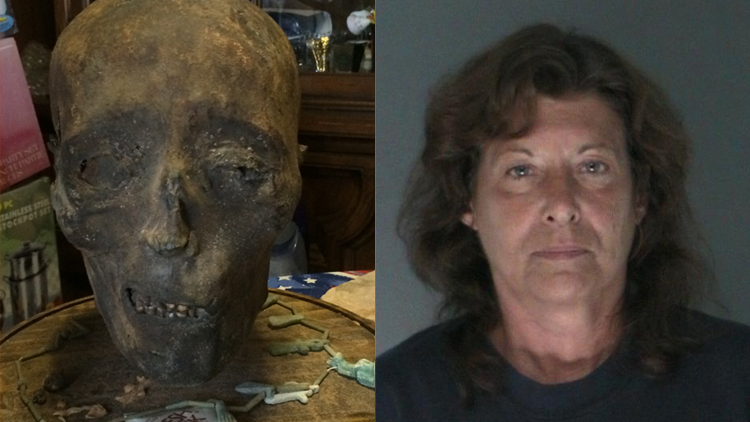The sun was setting on Long Island’s longest heat wave when Elaine Colbert allegedly shouldered through the locked side door of a brick-faced Lindenhurst home and stole an ancient Egyptian mummy head.
She initially knocked, but got no answer. Growing concerned about the friend she was there to see, Colbert knocked harder and louder. A neighbor overheard the commotion and told Colbert that her friend—the mother of her late ex-boyfriend, whom she visited monthly—had died.
“I heard some banging,” the witness later told Suffolk County police, according to court documents detailing the incident. “A few minutes later, Elaine came back, and she had a glass case that had a mummy head in it. Elaine wrapped the mummy head in a towel and said it was hers.”
Although the case got little coverage, aside from a brief mention in a local news outlet’s police blotter, it easily ranks as one of the weirdest, most macabre thefts in recent memory on LI.
It all started on Catskill Avenue shortly after 8 p.m. Monday, July 15, 2013—a sweltering week when LI broke its 20-year record for the lengthiest heat wave with weather worthy of the Sahara. The neighbor who witnessed the bizarre incident told Michael Snidersich—who still lives in the house he shared with his late mother. He in turn called 911. Four days later, Colbert was arrested.
When the victim reported the theft to police, he told investigators that the mummy head was 4,000 years old and worth $35,000. But the mummy’s identity is unclear and its value remains open to debate.
Colbert was originally charged with second-degree burglary, which is punishable by up to 15 years in prison. Last year, prosecutors dropped that charge and replaced it with two lesser counts: trespassing and petty larceny. That came after much head-scratching at her initial court appearance.
“Say that again?” Judge Paul Hensley said when Assistant District Attorney Melissa Grier told him what the 56-year-old woman was accused of stealing. “Mummified head?”
Colbert’s first defense attorney was equally baffled.
“I don’t know the value of a mummified head at this time,” her court-appointed Legal Aid lawyer, Adam Markou, conceded when prosecutors asked Hensley to set bail for Colbert at $15,000. After the counselor argued that Colbert should be released without bail, the judge set her bail at $200—all the cash her family told Hensley they had at the time.
Later, Colbert hired Mineola-based attorney James Pascarella, who negotiated a deal with prosecutors that spared her from landing in the tombs.
In February, Judge Derrick Robinson granted an adjournment in contemplation of dismissal—known as an ACOD for short—that let Colbert avoid either going to jail or admitting to the crime in open court. As long as she has no contact with the criminal justice system for six months, the case will be dropped and sealed. If she abides by those terms, it will be dismissed on July 30, just over two years after the mummy caper. If she doesn’t, she faces up to a year in jail.
“My client is giving up any rights to the mummy head which is involved in the allegation,” Pascarella told Robinson at the hearing on Feb. 5.
Pascarella said authorities never had a chance to estimate the value of the mummy head because “there were other issues with the case.” Robert Clifford, a spokesman for Suffolk County District Attorney Tom Spota, did not respond to a request for comment on the mummy’s value.
“Our position is my client never stole it,” Pascarella told the Press, adding that Colbert claimed her friend gifted the mummy head to her. “She had permission to be there, and she had permission to have the head.”
MUMMY SLIDE
Even murkier than the mummy head’s identity is why someone would want to steal it. A few clues were exhumed from Colbert’s signed statement to investigators describing the alleged theft.
“I only broke into the house and took the mummy head to protect it,” she said in the statement, according to police. Pascarella claims that Colbert only signed the statement; the police wrote it.
Colbert’s elderly friend kept the mummy head in a glass case on a serving table in the dining room.
“I ran through the house and went straight for the mummy head in the dining room because it was [her] pride and joy,” Colbert wrote. “I picked up the mummy head and put it in my car and drove home. When I got home, I put the mummy head on my computer table with a cover on it. When I had it at my house, I thought to myself, ‘Now what am I going to do with it?’”
Colbert wrote that the woman had “told me she smuggled the mummy head from Egypt in a vase sometime in the Eighties. She said she had a mummy foot also, but I never saw that.”
After the crime victim’s son reported the mummy head stolen, Suffolk authorities seized it from Colbert. To ensure the head wasn’t severed in modern times, investigators sent the remains to the New York City Medical Examiner’s Forensic Anthropology unit for testing.
“We found that it was an ancient mummified human head without any forensic significance,” Julie Bolcer, a spokeswoman for the agency, told the Press. While the investigators eliminated the possibility of the head being linked to any unsolved missing persons or murder cases, they did not determine exactly how “ancient” it is.
Snidersich countered that Colbert never had any rights to the mummy head. He said that the mummy head had not been smuggled, but was purchased legally. When he got it back from Suffolk authorities, he said the mummy’s mouth was missing a tooth or two.
“My dad got that piece off consignment,” says Snidersich, recalling the purchase in the 1970s. “I was there when he got it… He was going to resell it here.”
For reasons unknown, the family decided to keep the head instead. When his mother died two years ago, Snidersich inherited the mummy head—but only after his surviving brother said that he didn’t want it, he said.
The family had been told that the head was “procured” from the Valley of the Nobles in Egypt, but that is difficult to verify.
“It was not illegal to bring Egyptian antiquity into the country back then,” he says in his home decorated with Egyptian art. “I don’t know if it is or not now…”
Experts say that the ban on selling all antiquities in Egypt was initiated in the early ’70s
“My dad wasn’t hiding it,” Snidersich says. “It was wrapped in a towel in a piece of luggage. The guy at Customs unrolled it and said: ‘Who’s this, your uncle?’” He laughed at the memory. The mummy head was allowed to enter America.
When Snidersich was growing up, he and his brothers called the mummy head Kharis, from The Mummy horror movie franchise. When one of their brothers admitted he was afraid of it, the others would always wait for him to fall asleep and place the mummy head near his bed. Now, Snidersich hopes to sell the mummy head, which his family believed to be a priest of Amun during the Eighteenth Dynasty, which ruled ancient Egypt through 1292 BC.
RETURN OF THE MUMMY
Robert Brier, a renowned Egyptologist at LIU Post, said that he would need to see the mummy head in the flesh to verify that it’s real, but that it looks like a credible mummy head from photos that this Press reporter showed him. But he doubts the family’s claims.
“There’s always a story that comes with it,” he says. “I don’t think it’s worth more than $5,000.”
Regardless of whether its resale value is closer to that of a used car or a new luxury sedan, the Lindenhurst mummy head may be only one of two mummies on LI. The other resides at the Vanderbilt Museum, Mansion and Planetarium in Centerport, which is about to celebrate its 65th anniversary in July.
“No one has ever indicated that they have ever seen another mummy” on LI, says Stephanie Gress, director of curatorial affairs at the Vanderbilt Museum. The closest museum with a mummy is in Brooklyn. Gress notes that it’s possible there’s one in a private collection somewhere in Nassau or Suffolk but she’s unaware of it.
In 1931 William K Vanderbilt II, a legacy of the American railroad dynasty, paid £280 for his museum’s mummy from a merchant in Cairo. That cost is estimated to be between $18,000 and $29,000 today, when adjusted for inflation and the exchange rate, and it could be worth more given its rarity.
For decades, the Vanderbilt mummy has been the center of one of the museum’s most popular educational programs, drawing busloads of students eager to see it. But it’s also the subject of debate.
“The whole culture of displaying human remains is a very contentious practice,” Gress says. “Some people find it offensive…It’s a struggle to make sure it’s done in a respectable way.”
Back in Lindenhurst, the head of “Kharis” is back on the kitchen table in the glass case from which it was stolen. Where it will roll next is anyone’s guess.
























